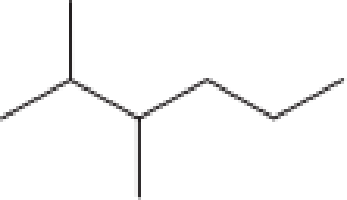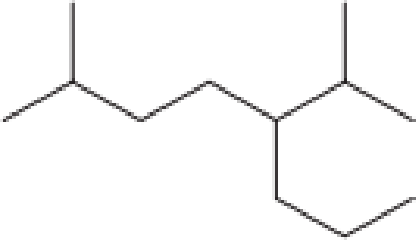
EBK GENERAL, ORGANIC, AND BIOLOGICAL CH
7th Edition
ISBN: 9780100853188
Author: STOKER
Publisher: YUZU
expand_more
expand_more
format_list_bulleted
Concept explainers
Textbook Question
Chapter 12, Problem 12.71EP
Assign an IUPAC name to each of the compounds in Problem 12-63.
a. 
b. 
c. 
d. 
Expert Solution & Answer
Want to see the full answer?
Check out a sample textbook solution
Students have asked these similar questions
Can someone explain this?
5. Drawn the structure of the compound (molecular formula C12H16) with the longest λmax in its
UV-vis spectrum.
Use solubility rules to complete balance molecular equations, and provide total and net ionic equations.
Chapter 12 Solutions
EBK GENERAL, ORGANIC, AND BIOLOGICAL CH
Ch. 12.1 - Prob. 1QQCh. 12.1 - Prob. 2QQCh. 12.2 - Prob. 1QQCh. 12.2 - Prob. 2QQCh. 12.3 - Prob. 1QQCh. 12.3 - Prob. 2QQCh. 12.4 - Prob. 1QQCh. 12.4 - Prob. 2QQCh. 12.4 - Prob. 3QQCh. 12.5 - Prob. 1QQ
Ch. 12.5 - Prob. 2QQCh. 12.5 - Prob. 3QQCh. 12.6 - Prob. 1QQCh. 12.6 - Prob. 2QQCh. 12.6 - Prob. 3QQCh. 12.6 - Prob. 4QQCh. 12.7 - Prob. 1QQCh. 12.7 - Prob. 2QQCh. 12.8 - Prob. 1QQCh. 12.8 - Prob. 2QQCh. 12.8 - Prob. 3QQCh. 12.8 - Prob. 4QQCh. 12.8 - Prob. 5QQCh. 12.8 - Prob. 6QQCh. 12.8 - Prob. 7QQCh. 12.9 - Prob. 1QQCh. 12.9 - Prob. 2QQCh. 12.10 - Prob. 1QQCh. 12.10 - Prob. 2QQCh. 12.11 - Prob. 1QQCh. 12.11 - Prob. 2QQCh. 12.11 - Prob. 3QQCh. 12.12 - Prob. 1QQCh. 12.12 - Prob. 2QQCh. 12.12 - Prob. 3QQCh. 12.13 - Prob. 1QQCh. 12.13 - Prob. 2QQCh. 12.13 - Prob. 3QQCh. 12.14 - Prob. 1QQCh. 12.14 - Prob. 2QQCh. 12.14 - Prob. 3QQCh. 12.15 - Prob. 1QQCh. 12.15 - Prob. 2QQCh. 12.16 - Prob. 1QQCh. 12.16 - Prob. 2QQCh. 12.16 - Prob. 3QQCh. 12.17 - Prob. 1QQCh. 12.17 - Prob. 2QQCh. 12.17 - Prob. 3QQCh. 12.17 - Prob. 4QQCh. 12.18 - Prob. 1QQCh. 12.18 - Prob. 2QQCh. 12.18 - Prob. 3QQCh. 12.18 - Prob. 4QQCh. 12 - Prob. 12.1EPCh. 12 - Prob. 12.2EPCh. 12 - Prob. 12.3EPCh. 12 - Prob. 12.4EPCh. 12 - Indicate whether each of the following situations...Ch. 12 - Indicate whether each of the following situations...Ch. 12 - Prob. 12.7EPCh. 12 - Prob. 12.8EPCh. 12 - What is the difference between a saturated...Ch. 12 - Prob. 12.10EPCh. 12 - Prob. 12.11EPCh. 12 - Prob. 12.12EPCh. 12 - Prob. 12.13EPCh. 12 - Prob. 12.14EPCh. 12 - Prob. 12.15EPCh. 12 - Prob. 12.16EPCh. 12 - Prob. 12.17EPCh. 12 - Prob. 12.18EPCh. 12 - Convert the expanded structural formulas in...Ch. 12 - Prob. 12.20EPCh. 12 - Prob. 12.21EPCh. 12 - Prob. 12.22EPCh. 12 - Prob. 12.23EPCh. 12 - Prob. 12.24EPCh. 12 - Prob. 12.25EPCh. 12 - Prob. 12.26EPCh. 12 - Indicate whether each of the following would be...Ch. 12 - Indicate whether each of the following would be...Ch. 12 - Prob. 12.29EPCh. 12 - Prob. 12.30EPCh. 12 - Prob. 12.31EPCh. 12 - Prob. 12.32EPCh. 12 - Prob. 12.33EPCh. 12 - How many of the numerous seven-carbon alkane...Ch. 12 - Prob. 12.35EPCh. 12 - For each of the following pairs of structures,...Ch. 12 - Prob. 12.37EPCh. 12 - Prob. 12.38EPCh. 12 - Prob. 12.39EPCh. 12 - Prob. 12.40EPCh. 12 - Prob. 12.41EPCh. 12 - What is the name of the IUPAC prefix associated...Ch. 12 - What is the IUPAC name for each of the following...Ch. 12 - What is the IUPAC name for each of the following...Ch. 12 - Prob. 12.45EPCh. 12 - What is the chemical formula for each of the...Ch. 12 - Prob. 12.47EPCh. 12 - Prob. 12.48EPCh. 12 - Prob. 12.49EPCh. 12 - Prob. 12.50EPCh. 12 - Prob. 12.51EPCh. 12 - Prob. 12.52EPCh. 12 - Draw a condensed structural formula for each of...Ch. 12 - Draw a condensed structural formula for each of...Ch. 12 - Prob. 12.55EPCh. 12 - Prob. 12.56EPCh. 12 - Explain why the name given for each of the...Ch. 12 - Prob. 12.58EPCh. 12 - Indicate whether or not the two alkanes in each of...Ch. 12 - Prob. 12.60EPCh. 12 - How many of the 18 C8 alkane constitutional...Ch. 12 - Prob. 12.62EPCh. 12 - Prob. 12.63EPCh. 12 - Prob. 12.64EPCh. 12 - Prob. 12.65EPCh. 12 - Prob. 12.66EPCh. 12 - Do the line-angle structural formulas in each of...Ch. 12 - Do the line-angle structural formulas in each of...Ch. 12 - Convert each of the condensed structural formulas...Ch. 12 - Convert each of the condensed structural formulas...Ch. 12 - Assign an IUPAC name to each of the compounds in...Ch. 12 - Prob. 12.72EPCh. 12 - Prob. 12.73EPCh. 12 - Prob. 12.74EPCh. 12 - For each of the alkane structures in Problem...Ch. 12 - Prob. 12.76EPCh. 12 - Prob. 12.77EPCh. 12 - Prob. 12.78EPCh. 12 - Prob. 12.79EPCh. 12 - Prob. 12.80EPCh. 12 - Prob. 12.81EPCh. 12 - Prob. 12.82EPCh. 12 - Draw condensed structural formulas for the...Ch. 12 - Draw condensed structural formulas for the...Ch. 12 - To which carbon atoms in a hexane molecule can...Ch. 12 - Prob. 12.86EPCh. 12 - Prob. 12.87EPCh. 12 - Prob. 12.88EPCh. 12 - Prob. 12.89EPCh. 12 - Prob. 12.90EPCh. 12 - Prob. 12.91EPCh. 12 - Prob. 12.92EPCh. 12 - Prob. 12.93EPCh. 12 - Using the general formula for a cycloalkane,...Ch. 12 - Prob. 12.95EPCh. 12 - Prob. 12.96EPCh. 12 - Prob. 12.97EPCh. 12 - Prob. 12.98EPCh. 12 - How many secondary carbon atoms are present in...Ch. 12 - Prob. 12.100EPCh. 12 - Prob. 12.101EPCh. 12 - Assign an IUPAC name to each of the following...Ch. 12 - Prob. 12.103EPCh. 12 - What is wrong with each of the following attempts...Ch. 12 - Draw line-angle structural formulas for the...Ch. 12 - Draw line-angle structural formulas for the...Ch. 12 - Prob. 12.107EPCh. 12 - Prob. 12.108EPCh. 12 - Prob. 12.109EPCh. 12 - Prob. 12.110EPCh. 12 - Determine the number of constitutional isomers...Ch. 12 - Determine the number of constitutional isomers...Ch. 12 - Prob. 12.113EPCh. 12 - Determine whether cistrans isomerism is possible...Ch. 12 - Prob. 12.115EPCh. 12 - Prob. 12.116EPCh. 12 - Prob. 12.117EPCh. 12 - Indicate whether the members of each of the...Ch. 12 - Prob. 12.119EPCh. 12 - Prob. 12.120EPCh. 12 - Prob. 12.121EPCh. 12 - Prob. 12.122EPCh. 12 - Which member in each of the following pairs of...Ch. 12 - Prob. 12.124EPCh. 12 - Prob. 12.125EPCh. 12 - Prob. 12.126EPCh. 12 - Answer the following questions about the...Ch. 12 - Prob. 12.128EPCh. 12 - Prob. 12.129EPCh. 12 - Prob. 12.130EPCh. 12 - Prob. 12.131EPCh. 12 - Prob. 12.132EPCh. 12 - Prob. 12.133EPCh. 12 - Write structural formulas for all the possible...Ch. 12 - Assign an IUPAC name to each of the following...Ch. 12 - Assign an IUPAC name to each of the following...Ch. 12 - Prob. 12.137EPCh. 12 - Prob. 12.138EPCh. 12 - Prob. 12.139EPCh. 12 - Draw structural formulas for the following...Ch. 12 - Prob. 12.141EPCh. 12 - Prob. 12.142EPCh. 12 - Prob. 12.143EPCh. 12 - Prob. 12.144EPCh. 12 - Prob. 12.145EPCh. 12 - Prob. 12.146EPCh. 12 - Prob. 12.147EPCh. 12 - Prob. 12.148EP
Knowledge Booster
Learn more about
Need a deep-dive on the concept behind this application? Look no further. Learn more about this topic, biology and related others by exploring similar questions and additional content below.Similar questions
- Use the literature Ka value of the acetic acid, and the data below to answer these questions. Note: You will not use the experimental titration graphs to answer the questions that follow. Group #1: Buffer pH = 4.35 Group #2: Buffer pH = 4.70 Group #3: Buffer pH = 5.00 Group #4: Buffer pH = 5.30 Use the Henderson-Hasselbalch equation, the buffer pH provided and the literature pKa value of acetic acid to perform the following: a) calculate the ratios of [acetate]/[acetic acid] for each of the 4 groups buffer solutions above. b) using the calculated ratios, which group solution will provide the best optimal buffer (Hint: what [acetate]/[acetic acid] ratio value is expected for an optimal buffer?) c) explain your choicearrow_forwardHow would you prepare 1 liter of a 50 mM Phosphate buffer at pH 7.5 beginning with K3PO4 and 1 M HCl or 1 M NaOH? Please help and show calculations. Thank youarrow_forwardDraw the four most importantcontributing structures of the cation intermediate thatforms in the electrophilic chlorination of phenol,(C6H5OH) to form p-chlorophenol. Put a circle aroundthe best one. Can you please each step and also how you would approach a similar problem. Thank you!arrow_forward
- A 100mM lactic acid/lactate buffer was found to have a lactate to lactic acid ratio of 2 and a pH of 4.2. What is the pKa of lactic acid? Can you please help show the calculations?arrow_forwardUsing line angle formulas, draw thestructures of and name four alkanes that have total of 7carbons, one of which is tertiary.Please explain this in detail and can you also explain how to approach a similar problem like this as well?arrow_forwardUsing dashed line wedge projections drawthe indicated compounds and indicate whether thecompound you have drawn is R or S.(a) The two enantiomers of 2-chlorobutane. Can you please explain your steps and how you would approach a similar problem. Thank you!arrow_forward
- 5) There are no lone pairs shown in the structure below. Please add in all lone pairs and then give the hybridization scheme for the compound. (8) 10,11 7) 1.2.3 H 4 | 14 8) COC 12 13 H 16 15 H7 9) - 5.6 C 8 H 10) H 1). 2) 3)_ 11) 12) 13) 4)_ 14) 5) 15) 16) 6)arrow_forwardThe sum of the numbers in the name of isA. 11; B. 13; C. 10; D. 12; E. none of the other answers iscorrect. I believe the awnser should be E to this problem but the solution to this problem is D 12. I'm honestly unsure how that's the solution. If you can please explain the steps to this type of problem and how to approach a problem like this it would be greatly appreciated!arrow_forwardConsider the following data for phosphorus: g atomic mass 30.974 mol electronegativity 2.19 kJ electron affinity 72. mol kJ ionization energy 1011.8 mol kJ heat of fusion 0.64 mol You may find additional useful data in the ALEKS Data tab. Does the following reaction absorb or release energy? 2+ + (1) P (g) + e → P (g) Is it possible to calculate the amount of energy absorbed or released by reaction (1) using only the data above? If you answered yes to the previous question, enter the amount of energy absorbed or released by reaction (1): Does the following reaction absorb or release energy? 00 release absorb Can't be decided with the data given. yes no ☐ kJ/mol (²) P* (8) + + + e →>> P (g) Is it possible to calculate the amount of energy absorbed or released by reaction (2) using only the data above? If you answered yes to the previous question, enter the amount of energy absorbed or released by reaction (2): ☐ release absorb Can't be decided with the data given. yes no kJ/mol аarrow_forward
arrow_back_ios
SEE MORE QUESTIONS
arrow_forward_ios
Recommended textbooks for you
 Organic And Biological ChemistryChemistryISBN:9781305081079Author:STOKER, H. Stephen (howard Stephen)Publisher:Cengage Learning,
Organic And Biological ChemistryChemistryISBN:9781305081079Author:STOKER, H. Stephen (howard Stephen)Publisher:Cengage Learning, General, Organic, and Biological ChemistryChemistryISBN:9781285853918Author:H. Stephen StokerPublisher:Cengage Learning
General, Organic, and Biological ChemistryChemistryISBN:9781285853918Author:H. Stephen StokerPublisher:Cengage Learning Introduction to General, Organic and BiochemistryChemistryISBN:9781285869759Author:Frederick A. Bettelheim, William H. Brown, Mary K. Campbell, Shawn O. Farrell, Omar TorresPublisher:Cengage Learning
Introduction to General, Organic and BiochemistryChemistryISBN:9781285869759Author:Frederick A. Bettelheim, William H. Brown, Mary K. Campbell, Shawn O. Farrell, Omar TorresPublisher:Cengage Learning- Chemistry: Matter and ChangeChemistryISBN:9780078746376Author:Dinah Zike, Laurel Dingrando, Nicholas Hainen, Cheryl WistromPublisher:Glencoe/McGraw-Hill School Pub Co
 Chemistry for Today: General, Organic, and Bioche...ChemistryISBN:9781305960060Author:Spencer L. Seager, Michael R. Slabaugh, Maren S. HansenPublisher:Cengage Learning
Chemistry for Today: General, Organic, and Bioche...ChemistryISBN:9781305960060Author:Spencer L. Seager, Michael R. Slabaugh, Maren S. HansenPublisher:Cengage Learning

Organic And Biological Chemistry
Chemistry
ISBN:9781305081079
Author:STOKER, H. Stephen (howard Stephen)
Publisher:Cengage Learning,

General, Organic, and Biological Chemistry
Chemistry
ISBN:9781285853918
Author:H. Stephen Stoker
Publisher:Cengage Learning

Introduction to General, Organic and Biochemistry
Chemistry
ISBN:9781285869759
Author:Frederick A. Bettelheim, William H. Brown, Mary K. Campbell, Shawn O. Farrell, Omar Torres
Publisher:Cengage Learning

Chemistry: Matter and Change
Chemistry
ISBN:9780078746376
Author:Dinah Zike, Laurel Dingrando, Nicholas Hainen, Cheryl Wistrom
Publisher:Glencoe/McGraw-Hill School Pub Co


Chemistry for Today: General, Organic, and Bioche...
Chemistry
ISBN:9781305960060
Author:Spencer L. Seager, Michael R. Slabaugh, Maren S. Hansen
Publisher:Cengage Learning
ENVIRONMENTAL POLLUTION; Author: 7activestudio;https://www.youtube.com/watch?v=oxtMFmDTv3Q;License: Standard YouTube License, CC-BY